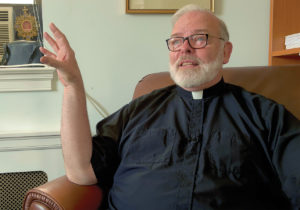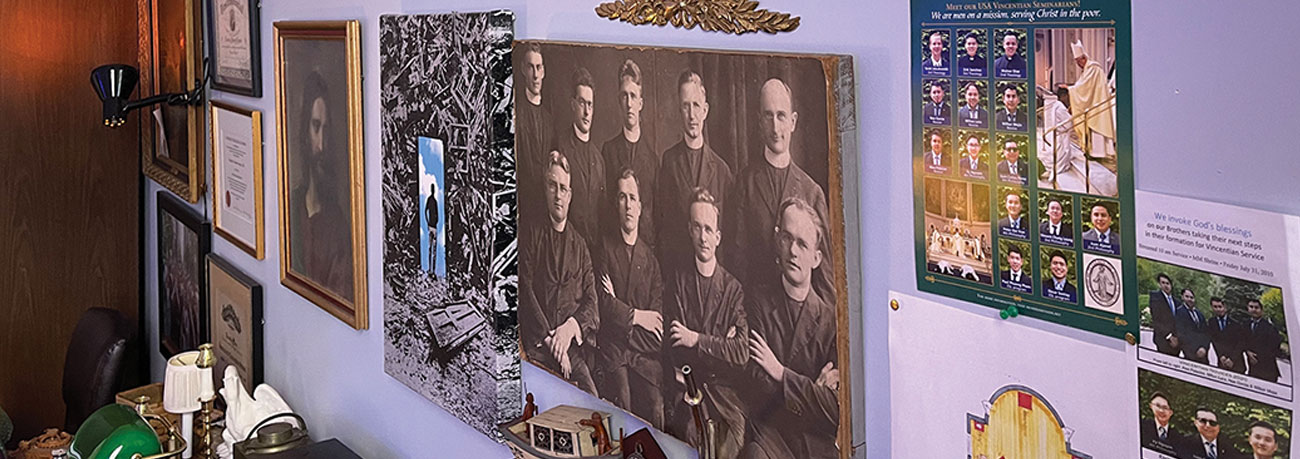100th Anniversary of Men on a Chinese Mission
100th Anniversary of Men on a Chinese Mission
In 1921, nine Vincentians risked their lives to spread the Catholic faith and devotion to the Blessed Mother in China.

Leaning on his cane but still towering in stature, Fr. Timothy Lyons, CM, entered his office and sat back in a classic, leather-upholstered office chair. The chair matched the aesthetic of the room, decorated top to bottom with artifacts and photographs from forgotten eras, all with their own intricate stories to tell. The smell of wood polish, old fabric, and history filled the office, and the sound of meticulously synchronized clocks ticked in hypnotic unison.
“So,” Fr. Lyons asked with a smile, “what would you like to know?”
The question seemed almost rhetorical. The vestiges of antiquity in the room offered infinite possibilities for questions. One worn, black and white photo, enlarged to cover almost a quarter of the wall, became the center of conversation. Printed on two large wooden slabs, the image depicted nine young priests; it was their story that sent Fr. Lyons through a fascinating discovery of an era long past.
When he discovered this old photo in a cluttered storage area, Fr. Lyons knew nothing about the priests or the context of the photo. Something about it, however, intrigued him, both as a Vincentian priest and a history buff.
After a conversation with Fr. Robert Mahoney, CM, he learned the names of all nine men in photo along with the background story. This was the group of young Vincentians setting out on the Vincentians’ inaugural mission to China in 1921: Frs. John O’Shea, Daniel McGillicuddy, Francis Meade, Thomas Crossley, and Leon Cahill; along with students Francis Stauble, John McLaughlin, John Colbert, and George Erbe. Each one was chosen to spearhead the mission of training priests, overseeing orphanages, building hospitals, and caring for the sick and starving.
Fr. Lyons soon discovered the silver lining to the COVID-19 lockdown: having an ample amount of time to delve into the Vincentian archives and feed his curiosity about these brave men of God. Gathering photographs, journals, and documents, he shared his findings with his confreres. Learning that several of the older Vincentians had lived with some of these missionaries after their return from China, he had yet another avenue to pursue.
It was the gradual unfolding of the heroism displayed by these Vincentian missionaries that inspired Fr. Lyons and his fellow priests. Through the seemingly endless quarantine and uncertainty about the future, they found parallels between their situations and those of the missionaries. That’s when Fr. Michael Carroll, Director of the Miraculous Medal Shrine, suggested that other people might find their stories compelling, too.
While the missionaries’ lives were filled with the adventure and sacrifice of life in a foreign land, they also offered a timely parallel to the fear and struggle permeating the lives of countless Americans during the pandemic. The decision was made to feature the priests and their adventures in our Solemn Novena (see “Solemn Novena,” page 7).
Their black and white photo depicts men who look stoic, youthful, and confident, yet the unexpected and unusual challenges they met made it clear that the mission was no place for the faint of heart. The hard work, inhospitable culture, and horrors of recurrent conflicts took a fierce toll on the health, lives, and mental well-being of the missionaries. Many returned to the United States in poor mental or physical health, if they returned at all.

China in the 1920s was a place of many warring factions. It wasn’t just the armies in the North and South, but also the dangerous bands of marauders, who were a constant threat to the Vincentians’ humble missionaries. The fortified walls around the mission protected them from the ongoing sieges, but the men quickly learned the cost of what they were undertaking.
Fr. John O’Shea, CM, was initially appointed as the superior, seven years later, was ordained a bishop, and later became the vicar apostolic of Kanchow. He remained in China until the 1950s when atheistic Communism finally battered the Church and ended the mission. He was arrested under trumped-up charges for his “subversive group,” the Legion of Mary. In prison, he was starved and abused, and when a Swiss Vincentian was finally able to negotiate for his release, Bishop O’Shea returned home in unbelievably poor health. After he recovered, he worked in the states until his death in 1969.
Fr. Francis Lewis Meade, CM, nicknamed Fr. Lou, was a bright and gifted professor who gave instruction and guidance to the four seminarians. But in his first year, Fr. Lou fell gravely ill, so Fr. Bartholomew Randolph, CM, a middle-aged seminary professor, was sent to replace him.
Fr. Randolph found himself traveling to China in the midst of the hottest season of the year—and one of the most violent. Bodies floated in the murky rivers, which were his only source of water. By the time Fr. Randolph joined his fellow confreres, he, too, had become deathly ill. His brothers cared for him the best they could, but despite all efforts, Fr. Randolph died just a few days after he arrived. After his funeral, Fr. O’Shea wrote home stating that in the future, only young Vincentians with the tenacity and fitness to withstand the harsh realities of the region should be sent.
The first of the seminarians to be ordained a priest in China was 28-year-old Francis Stauble. Early in his priesthood, his propensity for mathematics gained him the vital role of treasurer for the entire mission project. He joked with his brothers saying that he had come to China “praying for the courage to be a martyr…only to wind up a treasurer.” When Japanese air raids hit China, some of the Vincentians painted American flags on the rooves of their buildings to avoid attack; however, after America entered WWII, Fr. Stauble was expelled by Japanese forces amidst the chaos in 1943.
Mr. George Erbe was also ordained to the priesthood while he was in China and remained dedicated to the mission for the next eight years. During that time, he had become such an appreciated member of the group that, after returning to China from a short vacation in 1933, his parishioners walked a full day’s journey to welcome him back.
Known as one of the greatest modern Vincentian missioners, Brooklyn native John E. McLaughlin was the youngest at just 22 years old. “Fr. Jack” and his fellow missionary brothers set sail for China with an ambitious hunger for adventure. It wasn’t long before they found themselves in the middle of civil war. During this tumultuous period, Fr. Jack kept a journal, which would later be published by Fr. Joseph Skelly, CM, under the title, A Crusader Under Fire.
The last of the four seminarians, John W. Colbert, was a bit more mysterious. Ordained in 1923, Fr. Colbert made a name for himself during his first mission in Panama. His fellow Vincentians considered him one of their most steadfast and hardest working priests. From his letters, we know that he fell ill in Panama and reluctantly returned home, but his negative experience didn’t dissuade him from volunteering for the mission to China. However, during his time in China, fellow Vincentians begin to notice he was having some sort of internal struggle, which eventually resulted in his permanent separation from the Mission. Unfortunately, the details of Fr. Colbert’s personal journey continue to be a mystery.
Fr. Daniel L. McGillicuddy, CM, served in the Central Mission House of Kanchow. After Fr. O’Shea’s consecration as bishop, Fr. McGillicuddy became Mission Superior responsible for managing the Catholic primary schools, a school for adult catechumens, an elderly care facility, a home for the blind, and a medical dispensary for the poor. For more than two decades, Fr. McGillicuddy took on this massive responsibility with endless dedication and a light-hearted attitude, which raised the spirits of his fellow confreres during difficult times. He and his fellow missionaries were finally expelled from China by the Communist Party in 1945.

Serving in China for eight years, Fr. Thomas Crossley, the brawny priest from Brooklyn, became closely entangled in the ongoing Chinese civil war of the 1920s. Military presence was a near-constant threat to the mission, which drove Fr. Crossley to fearless confrontations with some of the officers and their trigger-happy bodyguards. It was his personal mission to stand up for the people in the Church of China, a mission he would hold deep in his heart even after returning to the United States.
Fr. Leon Cahill, CM, was ordained in Philadelphia during The Great War and the influenza pandemic of 1918. He had a realistic and level-headed idea of the kinds of struggles that awaited him and his brothers on their new mission. Before leaving for China, Fr. Cahill invited the congregation at the Chapel of the Immaculate Conception in Germantown to participate in the mission through their prayers and donations. He served in China for 11 years until 1932.
These brief introductions just touch on the stories of the nine brave Vincentians. During the 2020 Solemn Novena homilies, Fr. Lyons shared some of the artifacts they brought back from China, told an amusing anecdote about Fr. McGillicuddy scaring off the Chinese militia with a feather duster, and described his kinship with Fr. Crossley, who also possessed a near-obsessive affinity for clocks.
Fr. Lyons’s historic journey through time revealed a wealth of knowledge and personal discovery that led him a deeper insight about the Vincentians and their Mission to China—a plethora of inspiring, yet sometimes heartbreaking, stories of Catholic heroism amidst great trials. Stories that inspire us to embrace the faith fully and boldly and in the process, find deep meaning for our lives.


